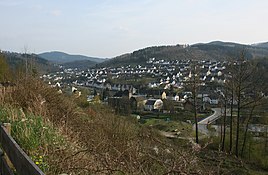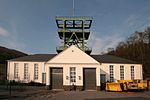Meggen (Lennestadt)
|
Meggen
City of Lennestadt
Coordinates: 51 ° 7 ′ 26 ″ N , 8 ° 4 ′ 4 ″ E
|
||
|---|---|---|
| Height : | 265 m | |
| Residents : | 2934 (Jun. 30, 2020) | |
| Incorporation : | 1st July 1969 | |
| Postal code : | 57368 | |
|
Location of Meggen in Lennestadt |
||
|
View of Meggen in April 2008
|
||
Meggen is a district of Lennestadt in the Olpe district in North Rhine-Westphalia .
Local development
For decades, the development of Meggen was heavily influenced by mining . The mining of pebbles in the area began in the 1850s. The development was favored from 1861 onwards by the connection of Meggen to the Lennetalbahn from Hagen to Siegen and the associated improvement in transport options. In 1951, a modern, central conveyor system was created with the Sicilia shaft. The upward trend reached its peak in 1955 - the population of Meggen grew to approx. 4,600. At times the mine operator, the former Sachtleben AG , was the largest zinc producer in Europe. Over time, changing world market conditions and environmental requirements made the further mining of pyrites unprofitable, so that the production operation was stopped in 1992.
The Sauerland pyramids built on the former mining site, which are a production, information and training center in the field of naturopathy (see also the following section: Sights), are an expression of a positive structural change. In this context, it is also worth mentioning the establishment of a supra-local workshop for the disabled, the renovation of brownfield sites and the flood-free expansion of the Lenne. The dismantling of the former mining site can be considered complete; 30 companies with a total of 360 employees were created.
The station building, which has since become a ruin, is being demolished; the city tries to find suitable investors for the development of the property. Further redevelopment tasks still to be solved concern the ailing railway underpass and some privately owned vacancies in the local area.
With currently 2,934 inhabitants as of June 30, 2020, Meggen is the third largest district of Lennestadt after Altenhundem and Grevenbrück. The share of 17.3% of the foreign residents is comparatively high due to the guest worker families who moved to the area during the mining industry (share of foreigners in the urban area 9.4%). The proportion of older residents over 65 years of age is 19.7%, above the city average of 17.4%. The secondary school at St. Barbara in Meggen was converted into a secondary school for the municipalities of Lennestadt and Kirchhundem from the 2014/15 school year .
Incorporation
Until June 30, 1969 Meggen belonged to the municipality of Elspe, then on July 1, 1969 it was incorporated into the new city of Lennestadt.
religion
The majority of the inhabitants of Meggen profess the Catholic faith. There was probably a chapel in Meggen as early as 1500 , as a churchyard is mentioned for the place in 1505. During the Thirty Years War the altar of this chapel was desecrated and destroyed. A second chapel was built in 1762 and expanded twice by 1887. Nevertheless, after a few years the chapel had already become too small for the place. In 1869 Meggen, which previously belonged to the parish of Elspe, had developed into an independent parish.
Pastor Stratmann, who was newly introduced to Meggen on September 13, 1888, took the inadequate space as an opportunity to deal intensively with the planning of a new church. The construction of the parish church of St. Bartholomew could finally begin in 1895; it was the after completion on September 15, 1896 Bishop August Gockel consecrated .
The listed church is built in the neo-Romanesque style and has a slender tower with an octagonal bell chamber. The entire structure consists of jointed rubble stones with many decorations.
The center of the choir is the neo-Romanesque high altar . It contains three reliefs with images of the Christmas, Easter and Ascension events. In 1904, the church received an organ made by the Stockmann Brothers organ building company, which is located on a brick loft projecting on three sides. An extensive renovation took place in 1981/82. The cath. The parish of St. Bartholomew belongs to the pastoral network of Meggen-Maumke-Halberbracht.
The small Marienkapelle, also called Heiligenhäuschen an der Steppel , is located on the old church path of the citizens of Meggen to the mother parish in Elspe . Several paths cross there, including to Theten , Maumke and Halberbracht . The original year of construction of the "holy house", which has existed "for ages", is not known. The site is documented in 1778 in connection with a Schnadegang (border inspection). The Holy House in its current form was built by the Düsseldorf architect Franz Schneider with funds from private donors. It is a small, square, plastered building with a pyramid roof. The small prayer room is closed by a wrought iron grille. In a figural niche there is a portrait of the Madonna with the inscription “A servant of Mary is not lost”. The church consecration of the small chapel took place on October 1, 1913. The little holy house and the property belonging to it were bequeathed to the local history association Meggen from a private owner in 2007. 7,000 euros were spent on the necessary renovation. The facility is carefully maintained under the supervision of the Heimatverein; it has been a listed building since 2008. On the occasion of the 100th anniversary of the consecration, the interior and exterior plaster of the chapel was renewed in 2013. In spring 2014, new seating was created.
Attractions
→ s. also list of architectural monuments in Lennestadt
The Sicilia Shaft Mining Museum has been in operation since the Sicilia Shaft was closed in 1992 . The entrance hall with the hoist cage, the engine room and an established museum can be visited.
The Kahle Wallburg is located about 500 m east of Meggen on the mountain top of the Kahle .
Also striking are the so-called Sauerland pyramids, a group of buildings on a hill directly next to the Siciliaschacht mining museum. The ensemble with the 15 meter high main pyramid was inaugurated on November 1, 2005. The construction phase and the opening triggered lively press coverage. The architects and builders won several awards for their design and implementation, most recently at the Light and Building 2008 trade fair in Frankfurt. The building complex with currently seven pyramids will u. a. used for the operation of a knowledge park, the training of alternative practitioners and the manufacture of biomedical devices.
As part of the Lenneschiene project (for more details, see Lennestadt # LenneSchiene project ), the Lenneufer near the Barbara Bridge was redesigned and the quality of the tree population, meadow and Lenne river made visible. Equipped with numerous seating areas, the bank has served as a popular recreational and play area since then. In the summer of 2017, the final project measures Haldengarten and Siciliaplateau were implemented. The plateau is a viewing balcony in the immediate vicinity of the former Sicilia mine; it provides a view of the town of Meggen, which extends in the valley by the Lenne. Below the viewing balcony, an adventure area (dump garden) for "young and old" was created along the dump that was used in mining times. Different slides made of precious metal are characteristic.
In addition to the parish church of St. Bartholomew, the little holy house on the Steppel and the Sauerland pyramids, there are several listed sights in Meggen, which have their historical origins in the earlier mining (which was discontinued in 1992). Particularly worth mentioning are the miners' settlement in Wolbecke (7 semi-detached houses built in 1919), the Sicilia mine built between 1950 and 1955, the Sachtleben Bergbau AG power station built in 1913 (machine hall and coal tower), the former transformer station built in 1920, the Statue of St. Barbara (patron saint of miners) on the Lennebrücke and the tunnel mouth hole in the Wolbecke.
There is a grave memorial for French prisoners of war in the cemetery in Meggen. The approximately three meter high stele was created in 1918. It is of high design quality and, as a French work, is rarely found in Germany. The illustrated documentation for the entry of the grave monument in the list of monuments of the city of Lennestadt contains more details.
Personalities
- Adolf Hennecke (1905–1975), miner and politician
- Christel Frese (* 1944), track and field athlete
Panoramic view of Meggen
swell
- Lennestadt. A place to live , publisher Stadtmarketing Lennestadt eV, Lennestadt, 2008
- Targeted improvement of structural conditions in Meggen , In: Westfalenblatt Zeitung for the Olpe district , 26. September 2009
- Ralf Breer and Otto Höffer: Churches and chapels in Attendorn, Lennestadt and Kirchundem . Edited by Sparkasse Attendorn-Lennestadt-Kirchhundem, Attendorn 1999, article p. 106 ff.
- Local law of the city of Lennestadt: List of localities
Web links
- Meggen (Lennestadt) in the Westphalia Culture Atlas
Individual evidence
- ↑ Lennestadt-Rathausreport, 3rd edition August 2009, p. 21
- ↑ cf. Article: The demolition excavator is already waiting , in: Westfalenpost, newspaper for Lennestadt and Kirchhundem, issue of June 13, 2019
- ^ Information from the city of Lennestadt
- ^ Local law of the city of Lennestadt: List of localities
- ↑ Georg Dehio , under the scientific direction of Ursula Quednau: Handbuch der deutschen Kunstdenkmäler. North Rhine-Westphalia II Westphalia . Deutscher Kunstverlag, 2011, ISBN 978-3-422-03114-2 , page 561.
- ↑ see also: Heiligenhäuschen on the Steppel turns 100, in Westfalenpost, local edition Lennestadt from September 26, 2013
- ↑ s. also: Heimatverein inherits Marienkapelle, in Westfalenpost, local edition Lennestadt from August 22, 2007
- ^ Sauerland pyramids, press reports
- ↑ "Energy Oscar" for the pyramids. In: Sauerlandkurier , April 13, 2008 ( online ( page no longer available , search in web archives ) Info: The link was automatically marked as defective. Please check the link according to the instructions and then remove this notice. )
- ↑ cf. also contribution Lenne lives! in Meggen, Haldengarten and Siciliaplateau will be opened shortly , in: Sauerlandkurier für Lennestadt, Kirchhundem, Finnentrop and the surrounding area, issue of September 9, 2017
- ↑ Grave memorial for French prisoners of war, PDF










